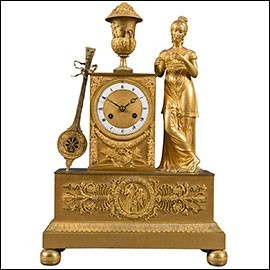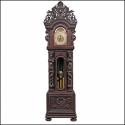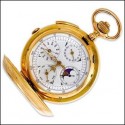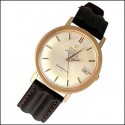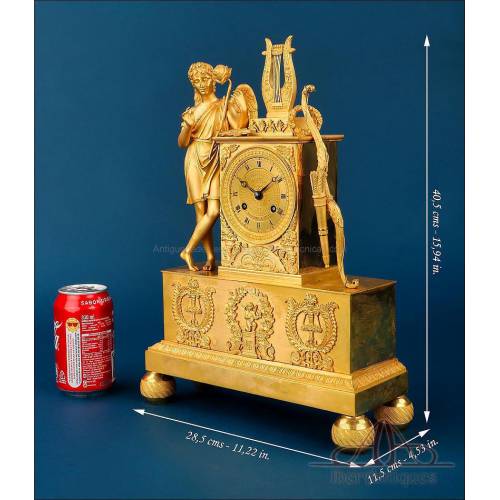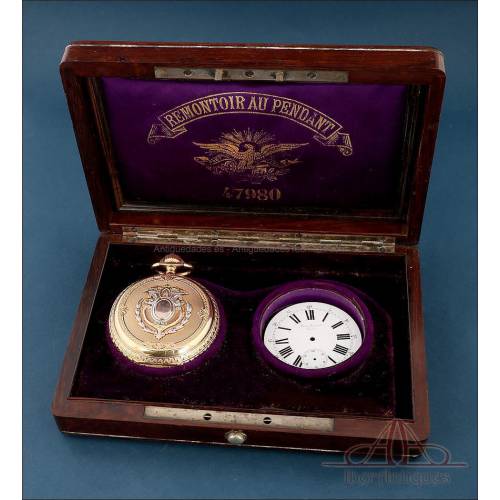Antique clocks and watches
Antique watches are a real passion for hundreds of thousands of collectors. These devices combine in their design all the qualities that are assumed of first-rate antiques: decades of history, functionality, beauty and charm. Because of the enormous interest in their intricate mechanisms and the fact that most function as well as they did when ...
Antique watches are a real passion for hundreds of thousands of collectors. These devices combine in their design all the qualities that are assumed of first-rate antiques: decades of history, functionality, beauty and charm. Because of the enormous interest in their intricate mechanisms and the fact that most function as well as they did when they were built, they are valuable items that continue to help us measure time accurately. From the earliest sunburst models to the atomic designs of the 21st century, clocks in general (and antique clocks in particular) have become objects of desire for lovers of vintage mechanical devices.
Time measurement and clocks: a brief history.
Since the dawn of mankind, humans have felt the need to measure time. There are indications that the majestic cromlechs, menhirs and megalithic alignments that dot the European geography performed functions related to the sun and the stars, being able to be considered the origin of sundials. However, it was not until 1,000-1,300 BC when the Egyptian civilization created the first known sundial. These models became very popular because of their simple and ingenious design: a simple bar nailed to a plate where a dial indicates the hours, which are indicated by the shadow. The reliability of the system meant that it was used until the 18th century to calibrate mechanical clocks. Water clocks (vessels with a hole through which the liquid was filtered, whose level marked the passage of time) also appeared in Egypt, but it was the Greek civilization that would create the first clepsydra: a large water clock with a more complex operation. Over the centuries, different types of ancient clocks continued to be developed, such as oil clocks (then known as spark plug clocks) or sand clocks.
At the end of the 12th century an invention appeared that would completely change the way of measuring time. It is the mechanical clock, which worked by a system of weights placed on a bar that was descending by a toothed shaft. A system regulated the descent of the weights to slow their descent. This early design was called the "escapement mechanism". In the 16th century Galileo Galilei published his famous study on the pendulum mechanism, which prompted Christian Huygens to build the first known pendulum clock. From this moment on, more and more precise and reliable mechanisms were designed, with magnificent designs present in all fields: architecture, fashion, decoration... Already in the 19th century, Alexander Bain designed and built the first electric clock. Throughout the first half of the 20th century, the clock mechanism evolved rapidly until the appearance of the atomic clock in 1946. Its margin of error of 1 second every 300 years makes it the most accurate clock ever built.
Types of antique clocks
The collector of antique watches has before him a vast and fascinating field, full of possibilities. Over the past centuries, clocks of all types have been made, from the most complex and valuable to the simplest and most reliable designs. Here are some of the most popular:
Antique mechanical watches . They are the best known, comprising pocket, tabletop, wall, wrist, grandfather type models... The mechanism can be winding or weight-operated, with pendulum or escapement, etc. One of the most interesting qualities of antique mechanical clocks is that they are often easy to repair by professional watchmakers, coming back to life to measure time with total precision.
Antique pocket watches . Of great elegance and intense evocative power, pocket watches are part of great collections throughout the world. Their origin is established in France in the mid-15th century.
Antique wristwatches . They were the logical evolution of the pocket watch towards a more practical and functional design. The first known wristwatch was made by Abraham L. Breguet in 1812 as a gift for Caroline Bonaparte, Napoleon I's sister.
Antique oil clocks . Also known as "silent clocks", they are an evolution of the spark plug clock invented in the 9th century. They became very popular in the 19th century, especially in those households where they could not afford to buy a mechanical clock.
Antique hourglasses . Hourglasses continue to be of interest to many collectors because of their simple and ingenious operation. The most famous of all is probably the one employed by Christopher Columbus on his voyage to the New World, which was 1.50 meters high.
Accurate, reliable and beautiful, antique clocks continue to measure time with admirable precision. The wide variety of mechanisms and designs displayed by these vintage pieces turns their pursuit and collecting into a lifelong hobby.
Subcategories
Antique Mantel Clocks
An attractively designed and well-functioning table or table clock is usually the focus of all eyes. If it is also an antique and original vintage item, then it will also become one of the most appreciated pieces by its owners. Antique table clocks have been decorating spaces for centuries; millions of homes around the world have some model that measures time with silent patience.
Brief history of antique table clocks or table clocks.
The origin of table clocks (also known as antique table clocks) is somewhat fuzzy, but can be established around the 14th century. The clock mechanisms of the time were oversized and ran huge designs located in cathedrals, churches and public buildings. When the dimensions of the mechanisms were reduced by replacing the weights with a spring system, clocks moved into the domestic sphere in the form of table, wall or floor models. From that time on, table clocks were manufactured with different types of mechanisms, although they all worked on the same principle: a spring motor transmitting the movement to gears, controlled and regulated by a mechanism (pendulum, weights, escapement, etc.). The gears turn the hands at a set rate.
Types of antique table clocks
Table clocks or antique mantel clocks can be classified into different groups. We can group them according to their mechanism, their design, their style, the materials they are made of... Among the most popular and attractive ones are the following:
Table clocks with Paris movements Also known as "Pendule du Paris" or "Clock of Paris" (in France and Great Britain), this mechanism does not actually correspond to a defined typology. The name "Pendules du Paris" refers rather to the place of manufacture and/or the Parisian style than to a specific mechanism. They are usually compact, round-shaped machines, designed for small cases (such as those of table clocks). They usually include hour and half-hour chimes on a bell or gong. Paris machineries are generally found in high quality sculptural clocks, made of marble, gilt bronze, etc.
Pendulum table clocks. . The invention of the pendulum mechanism is due to the Italian physicist and astronomer Galileo Galilei, who described it in a writing in the 15th century. Later, Christian Huygens built the first pendulum clock. Antique table clocks with pendulum are usually tall, slender designs to accommodate the pendulum element, which is often seen at the bottom through a glass panel.
Sculptural table clocks. . They are magnificent period designs whose case appears decorated with stylized bronze, calamine or porcelain figures. They were very popular in the 18th and 19th centuries, especially in France. The figures usually represent gallant or mythological scenes characteristic of Romanticism. The clock mechanism was hidden in a case that served as a pedestal for the sculptures, while the dial was displayed either on the front of the case or as part of the sculptural ensemble.
Table clocks made of marble, wood and gilded bronze. The use of noble and valuable materials to make table clock boxes made these objects authentic works of craftsmanship, which to this day still maintain their great beauty and attractiveness. Wooden boxes are probably the most common, using noble species such as mahogany or ebony in the manufacture of magnificent designs. Marble was widely used in the 30s of the twentieth century to manufacture beautiful art deco style table clocks. Gilded bronze (ormolu) was widely used in the manufacture of wonderful antique table clocks during the 19th century. Empire style, combined with ebony, with sculptural figures or with marble pedestals, these clocks stand out for their elegance, their luminosity and their complicated designs.
Collecting antique table clocks is an exciting hobby, which can also be an excellent investment. Watching them in good working order and enjoying their timeless beauty on a sideboard, mantelpiece or large dining table is a real pleasure.Antique Wall Clocks
If all antique clocks deserve a place in the best collections, antique wall clocks stand out for their beauty and decorative potential. They are more functional than grandfather clocks, because hanging on the wall they do not take up space; moreover, their medium size allows them to be placed in virtually any corner. Antique wall clocks are designed to stand out in living rooms or entryways because of their wonderful designs and good sound. These devices are manually wound, that is, they work when the mechanism is wound or the weights are activated.
The wall clocks can be grouped by typologies, divided based on the material with which the case is made, the time and style, the mechanism, the chime ... The first wall clocks date from the invention of the pendulum machinery. The description of this system is attributed to Galileo Galilei, who wrote about it in the 19th century. However, it was Christian Huygens who built the first mechanism. The first antique pendulum clocks were large and were placed in emblematic buildings; the reduction of the size of the machinery allowed the creation of the first wall clocks, floor clocks and table clocks.
Special mention should be made of the antique wall clocks made in the Black Forest (Germany). The earliest are believed to date back to the 17th century: their dial had a single hand marking the hours. The dark wooden cases, obtained from the region's forests, were often decorated with hand-carved carvings depicting leaves, branches, acorns and other plant motifs. This design evolved, as did the mechanisms: as early as the 18th century, the first cuckoo clocks appeared, famous designs in the form of a hut with an automaton bird that strikes the hours from the upper window. The cuckoo clock business generated great wealth in the Black Forest, giving work to all kinds of craftsmen: watchmakers, carvers, cabinetmakers, painters, turners...
Types of antique wall clocks
Antique pendulum clocks. These are the most popular wall clocks, along with weight clocks. There are models that incorporate both systems. The cases used to be made of wood, usually with noble species such as mahogany, walnut or ebony. They have a front door with glass through which the pendulum can be seen. There are magnificent French, English and German models (especially from the Black Forest region), some of which include beautiful brass or bronze pendulums with hand-made reliefs. For the clock to work the pendulum must be in motion; if we want to stop the clock, it will be enough to immobilize this piece.
Antique wall clocks with Vienna type machinery. . Under this name are known wall clocks with weight mechanism. The weights hang from chains that connect them to the machinery. One of the weights operates the clock, while the other starts the hour and half-hour chime. When such a watch has three weights, the third one activates the quarter chime: this mechanism is known as the carillon.
Antique wall clocks type "porthole". . This name corresponds to the classic French and Spanish oval-shaped clocks, consisting of a large round dial surrounded by a case with marquetry and turned. They are typical of the late 19th and early 20th century. Sometimes, the dial includes precious marquetry and inlaid details made of tortoise shell, mother-of-pearl, ebony...
Antique wall clocks with complications. With the name of complications are known devices that can include a clock, apart from the dial with hours and minutes. There are wall clocks with second hand, moon phases, calendar and even complementary devices, such as barometers and thermometers.
Antique wall clocks type "mouse trap". . The name of these clocks comes from their resemblance to the mousetraps that were built when they began to be manufactured, in the mid-18th century. They originate from the German Black Forest, specifically from the Furtwagen region. Their German name is. Lackschild uhr (lack schild means "shield with paint", and uhr, clock). They consist of a square plate of lacquered wood, usually surmounted by an arch at the top. Behind the plate is hidden the mechanism, from which hang the pendulum and weights. The lacquered wood used to be delicately decorated with decals of gallant images and Roman numerals.
All these antique wall clocks are part of a universe full of charm, magic and evocative power. Collecting them can be the most passionate hobby, which will lead us to discover real gems of mechanics and decorative arts.Antique Grandfather Clocks
Within the field of collecting, antique grandfather clocks deserve a section of their own for their beauty and spectacularity. Their imposing presence means that today they continue to be appreciated and used in decoration, where they shine in classic style environments and stand out as exclusive pieces in eclectic and contemporary interiors. In the early days, grandfather clocks were only available to the upper classes due to their high cost. In addition, their large size was only suitable for large rooms and high ceilings (some reach 2.40 meters in height). Nowadays, antique grandfather clocks are very valuable items made with fine woods and high precision mechanisms, reaching very high prices in stores and auctions.
Antique anteroom clocks are similar to grandfather clocks, but larger and with more sonorous mechanisms. Their name is due to the fact that they used to be placed in the entrance or anteroom of the houses to be able to hear the time from any space of the house. We also know these clocks as "grandfather clocks" old, a name that has its origin in the North America of the late nineteenth century.
History of antique grandfather clocks
Like that of all mechanical clocks, the history of grandfather or anteroom clocks dates back to the 17th century, when Galileo Galilei set about investigating the possibilities of pendulum motion for measuring time. His studies were put into practice by Christian Huygens, who manufactured the first known pendulum clock. Gradually the mechanism became more compact and smaller, until it gave rise to the first wall clocks. In 1658, the British Robert Hooke developed the first anchor escapement, which replaced the catalan escapement used until then. This mechanism allowed a shorter pendulum movement, which made it possible to manufacture narrower cases for wall clocks.
Hooke's discovery was seized upon by the English clockmaker William Clement, who in 1670 built the first grandfather clock on record. The clock was fitted with the royal pendulum (or pendulum seconds) mechanism created by Clement himself, with a margin of error of only 10 seconds a day. The clock was over 2.10 meters high and had glass panels on the front to show the pendulum and weights. Within a few years, Thomas Tompion (a very famous English watchmaker considered the father of British watchmaking) also began making grandfather clocks.
The name "grandfather clock" has its origins in a curious anecdote. In 1875, the American singer and songwriter Henry Clay Work made the tune "The Grandfather Clock"("The Grandfather Clock"), in which he told the story of a grandfather clock, very popular. The song's fame crossed borders and led to grandfather clocks, since then, also receiving the name Grandfather or "grandfather".
Antique grandfather clocks: materials
The antique grandfather clocks stand out for the high quality of the materials with which they are made. The cases are usually made of solid wood, usually noble species such as walnut, mahogany, cherry or even ebony. The front face has glass panels to show the dial, pendulum and weights. Many of these clocks are decorated with marquetry or inlaid details and hand-carved pieces in different styles (depending on the period and fashion). There are also models inlaid with brass or gilt bronze, and even with details decorated with gold leaf.
As imposing as they are elegant, antique grandfather clocks stand out in every space because of their designs and scale. They are pieces of enormous interest, both for collectors and for lovers of decoration and quality craftsmanship.Antique Pocket Watches
Antique pocket watches make up an exciting universe that includes authentic jewels made of precious materials, but also simple models full of charm and authenticity. In the days when wristwatches were still unknown, pocket watches were an indispensable accessory for measuring time. They were also elegant accessories that gave a glimpse of the social class and style of the wearer. Today, the fascination with antique pocket watches continues to live on: literary and aesthetic subgenres such as steampunk. which bases its imagery on the clocks, gears and mechanical contraptions of Victorian England and Jules Verne's France, have revived interest in these wonderful items. On the other hand, for any watch collector the pocket watch models arouse a very special interest, being highly sought after among experts.
History of antique pocket watches
The origins of the pocket watch can be traced back to the 15th century. They were then known as "portable watches" and their construction was made possible after the invention of the spring mechanism (coil spring). They were originally cylindrical or ovoid in shape, like the famous "Nuremberg eggs": slightly elongated spherical clocks, designed by the watchmaker Peter Heinlen in the 16th century in the city that gives them their name. During the 16th and 17th centuries, pocket watches were made in curious and whimsical shapes: animals, skulls, crosses... However, their mechanisms were not very precise. Moreover, they were luxury items intended only for the wealthy classes.
In the 18th century manufacturing was becoming cheaper and pocket watches became more affordable. As Adam Smith points out in his book The Wealth of Nations,at this time "a pocket watch which [...] could be purchased for twenty pounds, can now be purchased for twenty shillings". Already in the nineteenth century, the figure of the American Aaron L. Dennison is revealed as fundamental, to achieve mass production of such items through the company he founded in 1850 with Edward Howard. This company would later be known as the Waltham Watch Co, a pioneering firm and one of the leaders in the sector. After World War I, wristwatches began to replace pocket watches; however, to this day these models are still manufactured because of the enormous attraction they arouse.
Types of antique pocket watches
Among the many antique pocket watches that have survived to our days we find models with gold, silver, platinum, nielloed silver, silver-plated or gilded metal cases... There are also simple designs with plain covers and watches with elaborate decorations, engraved or inlaid. The watch case may have two, three or even four covers; some models include a dust cover that protects the mechanism, hidden behind the back cover. Antique silver and gold pocket watches usually have contrasts and marks that provide information about the country of manufacture, the goldsmith or silversmith, the weight of the silver or the karat of the gold. Gold or silver-plated pieces used to be marked with the word METAL.
High complication pocket watches. Unlike watches with simple mechanism, high complication watches include calendars, moon phase indicators, stopwatches and other devices along with the classic dial and seconds hand. They are high-quality models, highly appreciated among experts.
Antique pocket watches saboneta. The name derives from a French word meaning "little soap". These are the classic pocket watches with a front cover, which protects and covers the glass cover of the dial. To look at the time you have to press a button that opens the cover.
Antique pocket watches lepine. Unlike the saboneta watches, the lepine ones do not have a front cover. The dial is protected only by the glass panel. They are named after the French watchmaker Jean-Antoine Lepine, who in the 18th century created a special mechanism that made it possible to manufacture much flatter pocket watches.
Antique "miner's" pocket watches. In these watches the dial appears divided into 24 hours, which allows you to know what time it is and whether it is day or night. Also called "24-hour clocks", the name miner's comes from the work they do in the dark, where it is impossible to know whether it is day or night.
Antique pocket watches unfold hundreds of possibilities for the collector of special pieces. To start a collection is to step into an exciting adventure, where beauty goes hand in hand with precision and mechanical engineering.Antique Wristwatches
In the field of watchmaking, antique wristwatches combine the typical functionality of watchmaking mechanisms with the aesthetics of jewelry. With sober or subtly baroque designs; made of luxury materials or simple metals; with a dial to tell the time or with all kinds of complications (moon phases, chronometers...), they constitute magnificent complements destined to shine on the wrists of men and women. Wristwatches are a relatively recent invention, which in its day replaced the ubiquitous pocket watches. Today they continue to evolve and there are even space watches that operate at 0 gravity or models for divers that operate at depths of more than 100 meters.
Brief history of wristwatches.
The first portable watches date from the fifteenth century and were models attached to chains, intended to be carried in the pocket clipped to clothing. They had cylindrical or ovoid shapes and were only available to the wealthier classes. The first known wristwatch was built by the famous French watchmaker Abraham Louis Breguet in 1812 as a gift for Caroline, Queen of Naples and sister of Napoleon Bonaparte. However, it was not until the beginning of the 20th century that wristwatches began to become popular. During World War I, airline pilots needed a practical, small watch that could be worn for quick checks. The famous aviator Alberto Santos-Dumont asked his friend Louis Cartier to build him such a watch to wear on his wrist. Thus was born the famous Cartier-Santos watch, one of the first men's wristwatch models to appear on the market.
From this contest, wristwatches definitively ousted the pocket watches and began to be manufactured in all kinds of designs, materials and prices. The first automatic model that combined the winding mechanism with an inertia pendulum appeared in 1923, invented by John Harwood. Subsequently, the Rolex firm designed an automatic watch with a unilateral winding rotor that would later be imitated in all automatic watches, including those of today. In 1967 the first electronic watch with quartz engine was presented in Switzerland, pioneer of all the models that would come later and that today dominate the market for these items.
Vintage wristwatches: reference brands.
Vintage wristwatches were manufactured by all kinds of companies, from the most humble to the big firms. Nowadays, the most valued luxury wristwatches are signed by brands such as Rolex, Patek Philippe, Vacheron Constantin, Tag Heuer, Audemars Piguet, Chopard, Piaget.... On the other hand, some of the most important Swiss firms that contributed the most evolution to wristwatches (such as Omega or Longines, among others) continue to launch new models and take on new challenges in the 21st century.
Types of antique wristwatches
Vintage wristwatches can be classified according to styles, brands, materials, designs.... But perhaps the most accurate and practical classification is according to their operation. Depending on the type of mechanism, we can group them into two types:
Manual wristwatches . They are the pioneer designs, very popular until the 50s of the twentieth century. They have a side crown that allows winding the engine. Turning it tightens an internal spring that operates the gears, allowing the movement of the hands regulated by an escapement mechanism.
Automatic wristwatches . The automatic mechanism was invented in the early 1920s, but did not become popular until decades later. In addition to the manual winding system, they incorporate an autonomous mechanism with a pendulum that is set in motion by the movement of the arm. This allows the watch to run much longer (as long as it is in use). When the watch is not in use, it must be wound manually to start it.
Collecting antique or luxury wristwatches is something that fills their owners with satisfaction. From the magnificent designs of the big brands to the functional and practical antique models, these objects are a milestone in the history of industrial design.
Attractive Solid Wood and Inlaid Wall Clock. North America, 1920-30 Attractive Solid Wood and Inlaid...
Original and decorative wall clock with inlaid ornaments, made in North America in 1920-30. Original and decorative wall clock...
SoldAntique 18K Gold Pocket Watch. Minute Repeater, Chronograph, Switzerland 1890 Antique 18K Gold Pocket Watch....
Antique Swiss pocket watch in 18K gold, with minute repeater and chronograph, made circa 1890. In excellent aesthetic and functional condition, ideal for collectors. Antique Swiss pocket watch in 18K...
4 800,00 €Antique Edward Prior Verge Fusee Pocket Watch with Double Case, London 1771 Antique Edward Prior Verge Fusee...
Ottoman-style Edward Prior verge fusee pocket watch, London, 1771. Double silver case, decorated mechanism, and dial with Ottoman numerals. Ottoman-style Edward Prior verge...
SoldAntique Pocket Watch Stand in Wood and Boulle Marquetry, France, 1800 Antique Pocket Watch Stand in...
Elegant pocket watch stand in Boulle marquetry, with functional lock and brass details. France, circa 1800. Elegant pocket watch stand in Boulle...
950,00 €Rare Early Gold Cylinder Pocket Watch with 1/8th Repeating. England, c. 1770 Rare Early Gold Cylinder Pocket...
18K gold cylinder watch, two cases, with half quarter-repeating chime and early chronometer. Signed by William Hughes, London, c. 1770. Fine details and excellent preservation. 18K gold cylinder watch, two cases,...
15 500,00 €Antique English Clock for the Chinese Market with Rich Decoration and Moon Phases, Ca. 1880 Antique English Clock for the...
Majestic English clock from ca. 1880, with visible mechanism, perpetual calendar, and moon phases. Exquisite carved wood base and Chinese decoration. In pristine condition and working order. Majestic English clock from ca. 1880,...
3 500,00 € 3 800,00 €Reduced price!Antique Pocket Watch with Moon Phases and Calendar, Circa 1900. Antique Pocket Watch with Moon...
Elegant steel pocket watch, circa 1900, with calendar and moon phase complications. Fully functional, with manual month adjustment. Ideal for collectors. Elegant steel pocket watch, circa...
SoldAntique Swiss Pocket Watch, 18K Gold, 32 Jewels Minute Repeater, 1890 Antique Swiss Pocket Watch, 18K...
Swiss 18K gold pocket watch, circa 1890. Minute repeater, 32 jewels, mechanism protected by crystal. Excellent condition and operation, ideal for collectors. Swiss 18K gold pocket watch, circa...
SoldAntique Paul Jeannot Pocket Watch in 18K Gold. 20 jewel. Switzerland, 1880 Antique Paul Jeannot Pocket...
Paul Jeannot pocket watch from 1880, 18K gold. Three covers, with engraved and signed dust cover. Micrometric adjustment system, 20-jewel movement. Paul Jeannot pocket watch from 1880,...
7 500,00 €Antique Gilt Bronze Portico Clock with Four Columns. France, 19th Century Antique Gilt Bronze Portico...
Elegant gilt bronze portico clock, France, 19th century. Working condition. Elegant gilt bronze portico clock,...
2 300,00 €Antique Paul Boch Silver Pocket Watch For The Chinese Market, Switzerland, c. 1870 Antique Paul Boch Silver Pocket...
Swiss silver pocket watch, oriental style by Paul Boch, circa 1870. With original case. Swiss silver pocket watch, oriental...
1 500,00 €Antique Gilt Bronze Clock with Cupid. France, circa 1850 Antique Gilt Bronze Clock with...
Antique French gilt bronze clock with Cupid, circa 1850. Paris 7-day movement. Antique French gilt bronze clock with...
1 750,00 € 1 900,00 €Reduced price!Elegant Antique Pocket Watch with Minute Repeater, 18K Gold, Switzerland, 1890 Elegant Antique Pocket Watch...
Elegant pocket watch with minute repeater, 18K gold case, and engraved details. Made in Switzerland circa 1890, a treasure for collectors. Elegant pocket watch with minute...
SoldAntique 18K Gold Pocket Watch Paul Jeannot, Switzerland 1890 Antique 18K Gold Pocket Watch...
Exquisite 18K gold Paul Jeannot pocket watch, circa 1890. In perfect condition, includes original case and extra porcelain dial. Intricate decoration and 15-jewel movement. Exquisite 18K gold Paul Jeannot...
SoldBeautiful Antique Gilt Bronze Mantel Clock. France, circa 1840 Beautiful Antique Gilt Bronze...
Elegante reloj de sobremesa de bronce dorado al mercurio, circa 1840, en perfecto estado de funcionamiento. Elegante reloj de sobremesa de bronce...
1 750,00 € 1 900,00 €Reduced price!
New products
-

Antique ivory and silver plated stethoscope, late 19th century
Antique stethoscope from the late 19th century in silver-plated metal...
-

Vintage pendant with shell cameo of Jesús del Gran Poder, carved c. 1970
Vintage pendant with a shell-carved cameo of Jesus del Gran Poder, circa...
-

Antique Roman Style Gilded Silver Chalice with Paten. France, 1932
Antique Roman-style chalice in gilded silver with paten. France, 1932....
-

Beautiful Antique 18 K Gold Ring with 7 Natural Diamonds
Antique 18K gold ring with 7 natural diamonds. Delicate openwork design,...
-

Antique Silver Reliquary. José Vilaplana. Valencia, Spain. Circa 1920
Impressive repoussé silver reliquary by José Vilaplana, Valencia, c....
-

Vintage 18K Gold Ring with 7 Natural Diamonds
Vintage 18K gold ring with seven natural diamonds in floral setting....
-

Antique Silver Chalice. Enameled Crosses. Valencia, Spain, 1942
Spanish chalice from 1942 in solid silver, gifted by the Church of...
-

Antique Silver Chalice and Paten. Granada Spain, circa 1900
Spanish chalice in white silver with matching paten, handcrafted....
Specials
-

Amazing Antique Verge-Fusee Pocket Watch. Silver. 62 mm. Milden, Liverpool, UK, 1835
Exceptional silver verge-fusee watch...

